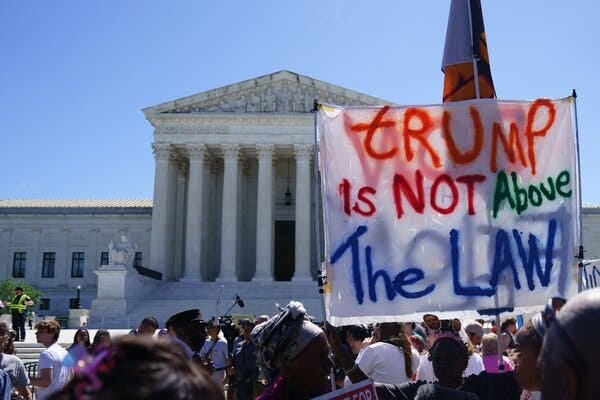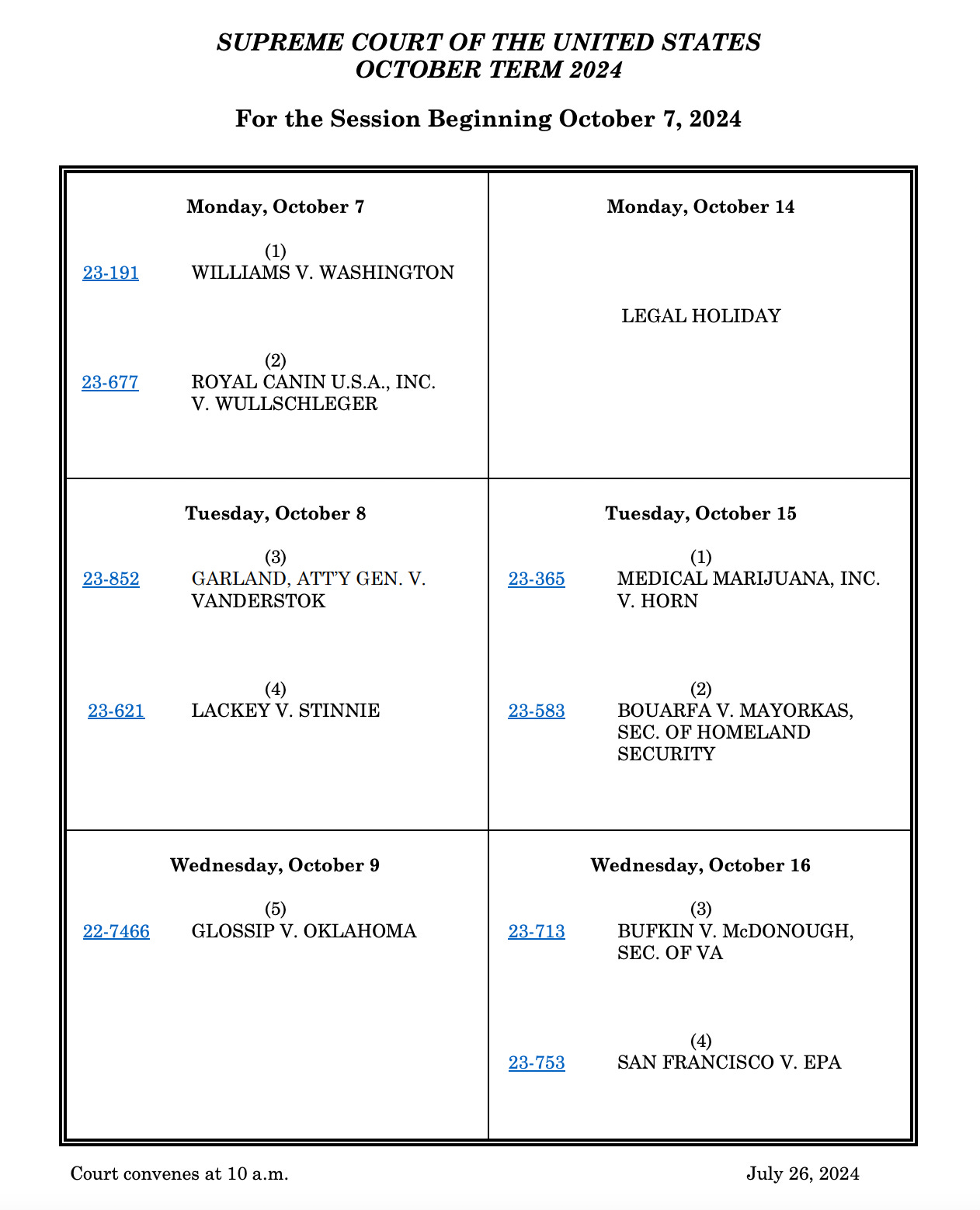The Week Ahead
October 6, 2024
It’s almost the first Monday in October. That means the start of a new term at the Supreme Court. Lots of Courtwatchers write “curtain raisers” ahead of the first day of Court, pieces that explain the cases that are coming and which are the important ones to look for. We’ll do a bit of that tonight, but it is impossible to write about the Court this year without acknowledging at the outset that something seems to be deeply broken on the inside.
Last month, the New York Times was out with some startling reporting. Chief Justice John Roberts, the supposed institutionalist, wasn’t. Roberts sent the other Justices a memo after Trump’s presidential immunity appeal came to the Court. In it, he “offered a scathing critique of a lower-court decision and a startling preview of how the high court would later rule, according to several people from the court who saw the document. The chief justice tore into the appellate court opinion greenlighting Mr. Trump’s trial, calling it inadequate and poorly reasoned … He wrote not only that the Supreme Court should take the case — which would stall the trial — but also how the justices should decide it.”
The reporting went on to relate that after Roberts circulated a draft of his opinion to the other Justices, “Justice Sonia Sotomayor, the senior liberal, signaled a willingness to agree on some points in hopes of moderating the opinion, according to those familiar with the proceedings. Though the chief justice often favors consensus, he did not take the opening. As the court split 6 to 3, conservatives versus liberals, Justice Sotomayor started work on a five-alarm dissent warning of danger to democracy.”
The conservative wing of the Court had a different reaction to the Chief’s draft opinion. The Times goes on to write, “Justice Brett M. Kavanaugh responded to what he called an ‘extraordinary opinion.’ In a final flourish, he wrote, ‘Thank you again for your exceptional work.’ Soon afterward, Justice Neil M. Gorsuch added another superlative: ‘I join Brett in thanking you for your remarkable work.’” Apparently, none of them lost sleep over the prospect of unleashing Trump, both from accountability for the insurrection and for what he might do in the future if he regained the White House. Power and party over country.
As startling as the contents of the reporting is the fact that reporters at The New York Times had the insider access necessary to write the story. Some of the information seems unlikely to have come from anyone other than one or more of the Justices themselves or someone with their explicit blessing to share it.
That casts the opening of Court in a much more somber light than usual. It’s almost certain Trump will be involved in cases before the Court again this term. At a minimum, there will be:
Round two of the presidential immunity appeal he hopes will prevent him from facing a jury in Washington, D.C.
An appeal from the Eleventh Circuit’s decision on Judge Cannon’s decision to dismiss the classified documents prosecution.
The inevitable post-election challenges Trump will bring if he loses.
Seemingly aware of that, the Court’s docket has been lighter than usual—they’re saving room. Even with the addition of fifteen cases late last week following the Court’s “long conference,” where it evaluated around 2,000 petitions and other motions, there is still room on the Court’s calendar for what they must know is coming. You can keep up with the cases the Court has set for oral argument each week on their calendar. Here is the schedule for week one.
In a sense, every case that makes it to the Supreme Court is, by definition, important. But some matter mostly to the parties or to a very limited group of people, while others have a broad application to a large part or even all of the country. Some of the cases in that later category that we’ll be following this term include:
Garland v. VanDerStok: Although this is a case about guns, it’s not a Second Amendment case. The case challenges the Biden administration’s efforts to regulate “ghost guns,” firearms that are sold disassembled and without serial numbers, frequently in easy-to-put-together kits. Last year the Fifth Circuit affirmed a federal judge in Texas who exempted ghost guns from laws that require background checks and serial numbers. The Biden Administration asked the Supreme Court to take the case, and the Court did, also allowing the regulations to remain in place by a 5-4 decision. In her brief early this year, the Solicitor General wrote that if the Fifth Circuit’s ruling is affirmed, “anyone could buy a kit online and assemble a fully functional gun in minutes — no background check, records, or serial number required” and that it would it create a “flood of untraceable ghost guns into our Nation’s communities, endangering the public and thwarting law-enforcement efforts to solve violent crimes.” You would think at least some “tough on crime” conservative Justices would find that persuasive, and a majority of the Court has twice ruled in favor of regulation on a temporary basis when the case hit the shadow docket, would do so again. But the Roberts Court is unpredictable.
Glossip v. Oklahoma: This is a death penalty case. Oklahoma’s Republican Attorney General no longer wants to execute the petitioner, Richard Glossip, because the record in this case is replete with prosecutorial misconduct and other errors, where even the state no longer defends the capital sentence. So, the Justices appointed a former clerk to Chief Justice Roberts to defend the conviction and sentence after serious, undisclosed issues emerged with the prosecution’s key witness. Glossip has been in prison for 26 years, and his execution has been scheduled at least nine times. However, multiple independent investigations have raised serious doubts about his conviction. The case comes to the Court as an increasingly irrational Donald Trump has called for executing “drug dealers.” The Court has limited the use of capital punishment to cases of murder.
United States v. Skrmetti: The Court must decide whether the Constitution prohibits Kentucky and Tennessee from limiting treatment for transgender youth. After the bans went into place, groups of transgender minors, their parents, and in Tennessee’s case, a doctor, challenge the constitutionality of the restrictions on due process and equal protection grounds after the Sixth Circuit permitted them to stay in effect. The Biden administration intervened in the case pursuant to a federal law that permits them to do so in cases alleging violations of the right to equal protection under the law that the Attorney General believes are of “general public importance.” Twenty-five states have enacted similar laws.
City and County of San Francisco v. Environmental Protection Agency:
The EPA took steps to force San Francisco to conform to its standards for discharges under the Clean Water Act. The challenge is to whether the EPA can impose generic prohibitions in discharge permits for violating standards without identifying specific limits discharges have to conform to. If the science seems a little hypertechnical, it is, but with the authority of administrative agencies in question after last term’s decision to all but end Chevron deference, this case has implications for both environmental enforcement and the ability of agencies to act. The Ninth Circuit ruled in favor of the EPA, saying its actions were related to its charge to protect the “integrity of the Nation’s waters” and create a scheme that would clearly define individuals’ obligations to control pollution. It rejected the pre-Clean Water Act status quo, where federal water quality was dependent on the standards set by each state. What a great idea. Let’s have each state set its own standards—or not. The Supreme Court’s decision will have a nationwide impact on the executive branch agency’s ability to engage in pollution control, and may offer the first decision about whether the Court expects lower courts to give any deference to agency decisions after last term’s ruling.
Patrick Daley Thompson involves the grandson of Richard J. Daley, Chicago’s mayor from 1955 to 1976, and the nephew of Richard M. Daley, who served as mayor from 1989 to 2011. Thompson was elected to Chicago’s city council in 2015. Four years earlier, he received bank loans for about $219,000, which he made only one de minimis payment towards. The bank failed after an embezzlement scandal involving some of its executives, and the bank’s president committed suicide. Thompson lied to FDIC investigators about the amount of money he owed the bank, although he subsequently agreed to repay all of it, minus interest. He was charged with making a false statement to influence a financial institution and convicted. He served four months in prison. On appeal, he argues that his statements to federal officers were “misleading” but not “false” and that making misleading statements is not a crime. Will this be a bridge too far for a Court that has, at virtually every opportunity, limited prosecutors’ ability to hold public officials accountable for corruption? Thompson says his conviction “threatens to criminalize a vast and ill-defined range of statements,” such as those made during mortgage negotiations. The Supreme Court has been susceptible to arguments like this about overcriminalizing elected officials’ behavior in earlier cases, like last term’s decisions that only “bribes” and not “gratuities” could form the basis for a prosecution, the difference being that a bribe was given in advance and a gratuity was offered after the fact. Splitting hairs like that has done nothing to resuscitate the public’s confidence in the Court.
Smith & Wesson Brands v. Estados Unidos Mexicanos: The Court will decide whether the Mexican government’s lawsuit against U.S. gun manufacturers can move forward. Mexico alleges the gunmakers aided and abetted illegal gun sales to traffickers who provided firearms to drug cartels in Mexico. Ironically, the case was granted the same week Trump’s Vice Presidential nominee JD Vance said Mexican cartels were bringing guns into the United States. That is not the case, and the Mexican government has registered complaints with Washington for at least the past fifteen years about the opposite—U.S. guns ending up in the hands of cartels. Whether Mexico can redress those claims in court remains to be seen.
These are a few of the most significant cases the Court will hear this term, beginning tomorrow morning. If you believe it’s important for Americans to understand how the Court works and what it’s doing—and how it affects all of us—I hope you’ll consider a paid subscription to Civil Discourse. Your paid subscriptions make it possible for me to devote the time and resources necessary to do this work, and I appreciate your support.
We’re in this together,
Joyce




So disheartening. In my 83 years, I cannot think of any other time when I have totally lost faith in SCOTUS.
I have no faith that the Robert’s Court will ever do the right thing. If it does, it’s a fluke.